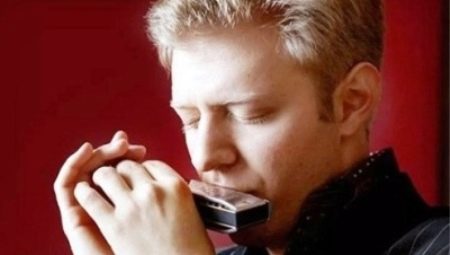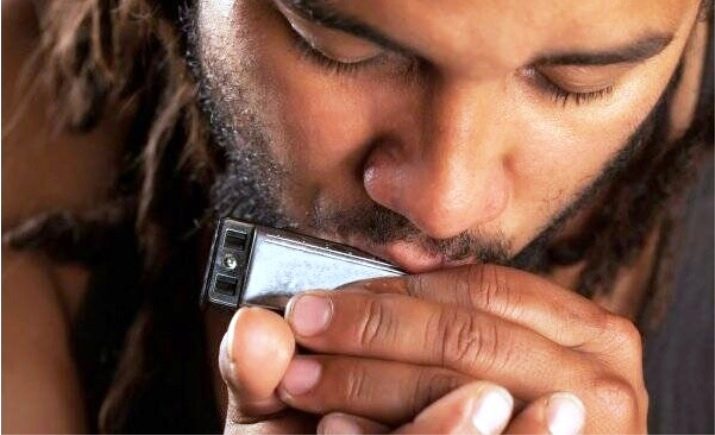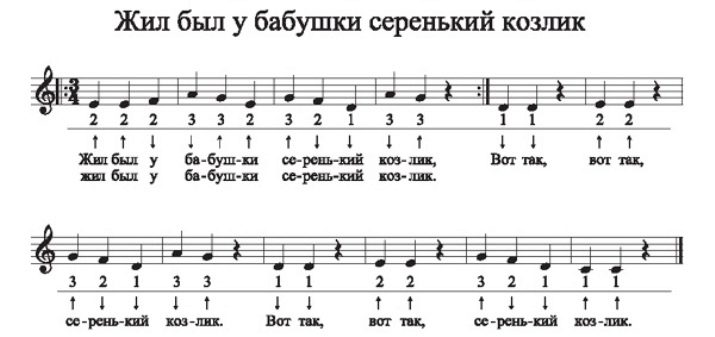How to play the harmonica?

Due to the large number of harmonicas available on the market, it is best for beginners to purchase the simplest C (C major) tuning instrument that has only 10 holes on the mouthpiece. Let it be either a regular diatonic model with one row of reeds, or a tremolo with holes in two rows.
How to keep?
Usually, a harmonica, which is small in size, is held in the left hand between the index and thumb in a horizontal position with the playing holes towards the musician. The index finger (together with the middle one) is placed on the top cover along the long side of the instrument body, and the thumb - along its lower side. In this case, the left edge of the harmonic should rest tightly against the crown (muscle edge) between these fingers.

Many performers with the left hand as the "main" hold the instrument in exactly the same way, but only use the fingers of the right hand for this. Further in the text, when describing any actions of the hands, the right-handed performer will be meant, and the left-handed musician simply needs to correct the information on his own to suit his natural characteristics.
Experienced harmonica music performers do not remain idle with their right hand either: it performs a variety of actions to change the sound. With her help:
- vibrato is performed;
- the dynamics of sound changes;
- chromatic notes (sharp and flat) are reproduced;
- the sound is given the "wah-wah" effect used when playing an electric guitar and other electric instruments through a special sound transducer (pedal);
- it is possible to play bands (also a guitar technique of changing the sound to a higher one).
In this case, the palm of the right hand is superimposed either on the side (on its side) of the accordion, or on the back side, where the blown air is released in order to influence its intensity. In the latter case, the fingers of the right hand are placed over the fingers of the left, and the base of the palm is located below the body over the thumb of the left hand.
However, the time has not yet come for a beginner to think about it. First of all, he needs to learn how to correctly blow into the mouthpiece of the instrument, reproduce a clean single sound and hit the right notes at the same time.
Now it is proposed to move on to the next question regarding the setting of the lips when playing the harmonica and correct breathing. Moreover, some of the aforementioned possibilities of the right hand cannot be performed on the diatonic model of the instrument.
Lip and breath setting
First, you should find out about the main difference between the harmonica and all other wind musical instruments. The fact is that in it, sound is produced not only during exhalation, but also during inhalation. Moreover, the sounds on the same hole during inhalation and exhalation are not identical - they have different heights.
On the schematic diagram of the C-major diatonic accordion mouthpiece, which is located below, this can be easily seen:

Thus, to get the C note of the first octave, you should blow into the first opening of the mouthpiece (that is, exhale). Remaining in place (at the first hole) and starting to inhale air through your mouth through it, you can hear another sound in height - the "re" of the first octave. The design of the accordion provides for various sound reeds and channels for the passage of air through them during inhalation and exhalation.
The first problem for novice musicians is the accuracy of the entry of air from the mouth on exhalation or, conversely, from the outside during inhalation into the desired sound channel (hole) of the mouthpiece.
The dimensions of the harmonica are quite small, therefore, the distances between the channels are so small that at the moment the lips cover the mouthpiece, several holes can enter the air stream zone at once. Targeting one sound is not easy at all.
For this case, there are 2 main ways to produce a single note.
- The first of them among the musicians-harpers is jokingly called "the kiss" for the similarity of adopting the shape of the lips with the intention of kissing someone in a relative way (on the cheek or forehead). In another way, it is called the "whistle" method. At the same time, the corners of the lips are pressed against the teeth, and the middle of the lips is rounded and pushed forward (all this is done with the help of the corresponding muscle groups). In this case, you need to try to arrange the "air channel" obtained from the lips in such a way that the air is pointwise aimed at the desired sound hole of the mouthpiece. But at the same time, a strict rule should be observed: the mouthpiece of the harmonica should always be between the lips, and not in front of them.

- The second method uses the blocking (closing) of adjacent holes with the tongue and corners of the lips. Lips capture 3 or 4 holes of the accordion, of which only one is left open, and 2 or 3 "unnecessary" ones are blocked by the tongue. This method is much more complicated than the previous one, but it has its own advantages, in connection with which it is also necessary to learn how to use it. In addition, only this position of the lips is used for the simultaneous extraction of several sounds (double harmonies and chords). When playing chords, the help of the language will also be needed to give rhythm to the composition.
Breathing will develop in the process of mastering the technique of playing the harmonica. The beauty and intonation of sound depends on the correct positioning of hands, lips, accuracy and density of the air stream.
There are various guidelines for choosing the first practice exercises for beginners, but most still tend to believe that the first thing to do is learn to play single notes.And the most useful for fixing a position, memorizing notes, developing hearing and breathing will be playing the C major scale in an upward and downward movement.
Tablature
The existing tutorials for teaching this unique musical instrument from scratch mainly use tablature to record harmonica drills and melodies. It is an alternation of numbers, meaning the numbers of the sound holes of the harmonic, into which you need to successively blow to play a particular melody. Due to the fact that each hole can reproduce two different sounds depending on the direction of the air flow, next to the numbers (in front of them or after them) they write the sign "-" if the note is played on inhalation, or "+" if a sound is required on exhalation. For example, here is what the tablature of the C major scale looks like in upward and downward movements:

In some sources, the same entry can be seen in other variants:
- 4 -4 5 -5 6 -6 -7 7 -7 -6 6 -5 5 -4 4, where exhalation is indicated simply by a number, the "+" sign is omitted;
- 4 (4) 5 (5) 6 (6) (7) 7 (7) (6) 6 (5) 5 (4) 4, where inhalation is enclosed in brackets, for example (4), and exhalation is enclosed in a number without additional symbols ...
- ↑ 4 ↓ 4 ↑ 5 ↓ 5 ↑ 6 ↓ 6 ↓ 7 ↑ 7 ↓ 7 ↓ 6 ↑ 6 ↓ 5 ↑ 5 ↓ 4 ↑ 4 (in this case, ↑ means exhale, and ↓ means inhale).
In addition, inhalation can be indicated by other signs: a number in a circle, a circle above the number, a dash above the number, and so on. In general, it is not difficult to figure it out, since the number on the exhale is usually clear of additions.
It must be remembered that the varieties of harmonicas in order and number of sound holes are not less than the tonalities in music theory or these very holes, therefore the tablatures of the C major scale or any other melody for different models may not coincide (or rather, they cannot coincide). It is for this reason that it is better to master musical notation and compose your own notes when beautiful simple blues melodies or your own improvisations of already known compositions come to mind. Although this is still to be done, it is worth understanding the notes at the beginning of the path.

This approach to learning is more rational than playing by numbers all your life. Tablature does not give rhythm (duration) of individual sounds or chords, therefore, when choosing unfamiliar melodies for a mediocre musical ear, it will bring many mistakes in this regard.
Technique of the game
You can learn how to play the harmonica correctly by taking a few beginner lessons from the pros to help you master the positions for playing both single notes and playing chords. In some places of residence, especially in large cities, there are music schools, in which there are sure to be teachers of this direction.
To help self-taught harpers, educational materials can come in the form of self-instruction manuals and schools for playing the harmonica by foreign and domestic authors.

From domestic, the following textbooks can be noted:
- K. Smolin “Harmonica. Self-study guide ";
- Beletskaya M. "A self-instruction manual for playing the harmonica";
- V. Skalozubov "School of harmonica playing tremolo and octave";
Of foreigners, she is attracted by Phil Duncan's “School for Harmonica Playing”, as it has been translated into Russian.
In all of these tutorials, lessons start from scratch and continue until the study of virtuoso strokes on the instrument, including bands, tremolo, vibrato, glissando.
There are good video tutorials on the Internet on the initial training in playing the mouth diatonic harmonica, master classes from high-class specialists on further improving the performance for those who have already achieved some success with this instrument. The famous virtuoso performer Boris Plotnikov has a very interesting version of sound production of single and chord sounds (pictured below).

It offers an easy way to reproduce sounds based on the unusual position of the instrument between the lips. - at an angle of 30-35 degrees with the support of the mouthpiece on the lower lip and almost 2/3 of the upper lid of the accordion covering the upper lip. The lower lip, therefore, is the main blocker of the currently "unnecessary" holes of the instrument when playing a single note.
We suggest evaluating this method yourself by watching the video below.








